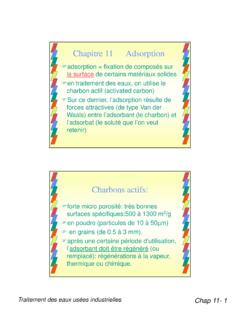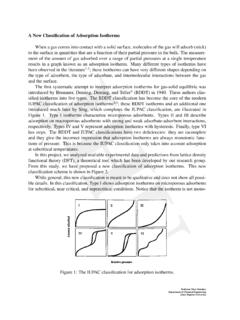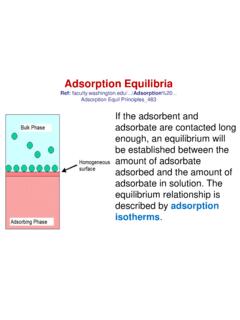Transcription of Investigation of carbon dioxide adsorption by …
1 62 Investigation of carbon dioxide adsorption by nitrogen - doped carbons synthesized from cubic MCM-48 mesoporous silicaYoung-Jung Heo, Minh-Uyen T. Le and Soo-Jin Park Department of Chemistry, Inha University, Incheon 22212, KoreaKey words: MCM-48, nitrogen - doped carbons, CO2 adsorption , thermal gravimetric analysis methodReceived 7 September 2015 Accepted 17 March 2016*Corresponding AuthorE-mail: +82-32-860-8438 Open AccesspISSN: 1976-4251 eISSN: 2233-4998 carbon Letters Vol. 18, 62-66 (2016)NoteArticle InfoCopyright Korean carbon Society dioxide (CO2) is a component of the flue gas of power plants and automobile emissions.
2 This gas is recognized as a primary greenhouse gas and is a presumed agent of climate change [1,2]. The drawbacks of the traditional MEA liquid method that is used for CO2 capture include the requirement for heavy equipment, and the toxic, flammable, cor-rosive, and volatile nature of the process [3]. Therefore, CO2 capture by means of adsorption in porous materials has received increasing attention because this method has proven to be superior than the conventional technologies in terms of the advantages associated with it. Compared to traditional processes, the convenient reversibility of adsorption on porous solid materials based on physisorption for the capture and release of CO2 makes this tech-nique a greener and more cost-efficient method.
3 To date, a variety of solid-based materials have been intensively studied for gas adsorption , especially CO2 capture, such as metal or-ganic frameworks, covalent organic frameworks, zeolites, activated carbons, functionalized graphene, carbon molecular sieves, chemically modified mesoporous materials, etc [4-13]. Furthermore, the low concentration of CO2 in flue gas (ca. 15%) requires selective separa-tion from the large volume of other component gases, mainly N2 [14]. Ideally, solid sorbents designed for CO2 capture should offer reduced energy consumption for regeneration, greater capture capacity, stability, selectivity, ease of handling, reduced environmental impact, etc.
4 Currently, there is significant interest in the development of solid carbon adsorbents that are capable of selectively adsorbing CO2, because of their large surface area, porosity, abun-dance, cost efficiency, low density, fast adsorption kinetics, and high chemical and thermal stability [15-18]. Furthermore, these materials offer some advantages in terms of ease of handing, pore structure, and surface characteristics, as well as low-regeneration energy [19]. Therefore, carbon materials are currently considered attractive candidate sorbents for CO2 capture in the development of alternate clean and sustainable energy technologies.
5 Based on these strengths, increasing efforts have recently been devoted to the synthesis of ele-ment- doped porous carbons that combine the high porosity and unique properties of doped carbon frameworks. The MCM-48 templated carbons have a high porosity without activa-tion usually required to develop an accessible porous structure. nitrogen doping has earned particular distinction because of the enhanced surface polarity, electrical conductivity, and electron-donor tendency conferred to the mesoporous carbons by nitrogen incorporation, which enables their application in CO2 capture, electric double-layer capacitors, fuel cells, catalysis, etc [20,21].
6 In the present study, we describe an alternate approach for the pro-duction of nitrogen -containing carbon materials with a cubic structure that facilitates CO2 diffusion and capture. Fig. 1a presents the low angle X-ray diffraction (XRD) pattern of pattern exhibits several well-resolved peaks in the low-angle range of 2 = 2 6 , which can be indexed as the (211), (220), (420), and (332) diffraction peaks; this pattern corresponds to the cubic Ia3d space group [2,22]. In Fig. 1b high-angle XRD patterns, the synthesized carbon materials show two apparent peaks at around 2 = 25 and 44 , which correspond to the (002) and (101) diffractions of the graphite structure, involving the hexagonal gra-phitic site and rhombohedral graphitic site, respectively [23].
7 Low-angle XRD patterns of the carbons synthesized with various amounts of pyrrole were acquired, as shown in Fig. DOI: is an Open Access article distributed under the terms of the Creative Commons Attribution Non-Commercial License ( ) which permits unrestricted non-commercial use, distribution, and reproduction in any medium, provided the original work is properly review: role of interfacial adhesion between carbon blacks and elastomeric materialsMin-Joo Kang, Young-Jung Heo, Fan-Long Jin and Soo-Jin ParkKCS Korean carbon Society : 1976-4251 eISSN: 2233-4998 REVIEWSVOL.
8 18 April 30 2016CO2 adsorption by nitrogen - doped MCM-48 templated carbons63 microscopy (TEM) images of the MCM-48 template and the carbon materials are presented in Fig. 2a and b. The TEM image from the thin edges of the carbon particles shows that the carbon molecular sieve has a uniform pore distribution. The ordered cubic Ia3d mesostructure of MCM-48 can be seen in Fig. 2a. Furthermore, the TEM image of the inset in Fig. 2b indicates an ordered I4132 structure of after replica-tion from the MCM-48 template (Fig. S1 and S2) [28]. Scanning electron microscopy demonstrated that the morphology of the NMK-1 porous carbons changed after the nitrogen -doping pro-cess using pyrrole (Fig.)
9 2c and d).Fig. 3 shows the nitrogen isotherms of the porous carbon ma-trixes obtained from the mesoporous silica MCM-48 template us-ing pyrrole, as described above. The NMK-1-0 sample had a large specific surface area (about 1330 m2 g 1) and large primary pore volume ( cm3 g 1) (Table 1). Therefore, the nitrogen specific surface areas provided here are roughly estimated and the actual 1. The intense peaks at 2 = and in the profiles of the synthesized carbon materials indicate long-range ordering of the highly ordered, uniform mesopores [24].
10 However, the structure of the resultant carbon material is different from that of the parent template MCM-48. Interestingly, the first intense (110) peak that was not observed for the MCM-48 template is apparent in the profile of the synthesized carbons; this is ex-plained by proposing that the carbon networks were formed from two bicontinuous interconnected mesochannel systems of the MCM-48 structure (with Ia3d symmetry) constructed from two helical chains [25,26]. Due to the disconnectivity of the two sets of helix channels, 3D, cubic, bicontinuous, mesostructured replicas with two single-crystal nanowires that are periodically and helically twisted, which did not follow a simple replication of the template mesostructure-like, 2D hexagonally arranged pores, were generated [26].






